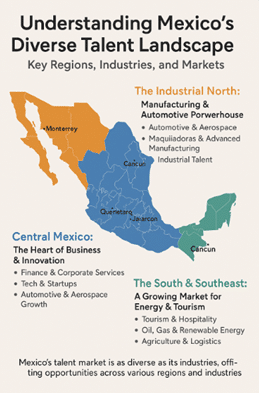- Blogs & Articles
Understanding Mexico’s Diverse Talent Landscape: Key Regions, Industries, and Markets
Mexico is a powerhouse of talent, offering a dynamic labor market across diverse regions and industries. As companies expand their operations or strengthen their talent strategies in the country, understanding the nuances of each region is crucial. From manufacturing hubs to booming tech ecosystems, let’s explore the key talent markets in Mexico and their industry strengths.
1. The Industrial North: Manufacturing & Automotive Powerhouse
The northern region of Mexico, including Monterrey, Saltillo, Ciudad Juárez, and Tijuana, is the backbone of the country’s manufacturing sector. This area is known for:
- Automotive & Aerospace: Global giants like General Motors, Kia, and Bombardier have operations here, driving demand for engineers, supply chain professionals, and technicians.
- Maquiladoras & Advanced Manufacturing: Many U.S. and international companies operate in border cities to leverage Mexico’s skilled labor force and trade agreements.
- Industrial Talent: A high concentration of engineers, logistics experts, and skilled technicians makes this region attractive for foreign direct investment.

2. Central Mexico: The Heart of Business & Innovation
The Bajío region (León, Querétaro, and San Luis Potosí) and Mexico City are economic engines with diverse industries:
- Finance & Corporate Services: Mexico City, Latin America’s second-largest financial hub, is home to multinational banks, consulting firms, and corporate headquarters.
- Tech & Startups: Guadalajara, often called the “Mexican Silicon Valley,” is booming in software development, AI, and fintech, attracting both local and international tech talent.
- Automotive & Aerospace Growth: The Bajío region has seen a rise in high-tech manufacturing, requiring a highly specialized workforce.
3. The South & Southeast: A Growing Market for Energy & Tourism
The southern states, including Mérida, Cancún, and Oaxaca, have distinct talent markets:
- Tourism & Hospitality: The Riviera Maya (Cancún, Playa del Carmen, and Tulum) relies heavily on bilingual professionals in hospitality, marketing, and customer service.
- Oil, Gas & Renewable Energy: With Pemex operations in Tabasco and Veracruz, as well as renewable energy projects in Yucatán and Oaxaca, this region is vital for energy sector professionals.
- Agriculture & Logistics: Southern Mexico continues to grow in agribusiness, particularly in exports of avocados, berries, and coffee, requiring logistics and supply chain talent.
Final Thoughts
Mexico’s talent market is as diverse as its industries, offering opportunities across various regions. Whether you’re looking to hire engineers in Monterrey, software developers in Guadalajara, or hospitality professionals in Cancún, understanding regional strengths will help refine your recruitment strategy.
As businesses continue expanding in Mexico, what talent trends are you seeing in your industry? Let’s connect and discuss!

Christian Scandella
Head of RPO Latin America
Christian Scandella is a seasoned recruitment industry professional who is spearheading efforts in Latin America to increase Hudson RPO’s presence and stature throughout the region and is also responsible for overseeing the firm’s talent acquisition efforts there. Christian has more than 25 years of industry experience, building and leading RPO organizations in Latin America. He also has proven success supporting global programs. He has founded and scaled several RPO companies across Latin America, driving regional talent acquisition solutions.
Sign up to receive the latest recruitment insights and Hudson RPO news.





